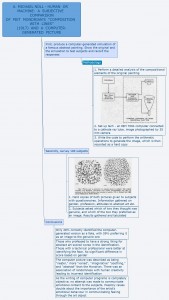There has in recent times been a shift in public art from works involving commissions by various urban councils and public agencies to a more community based work where a pedagogical aspect is emphasised, encouraged and valued.
“Community” is this respect usually gets defined in terms of minorities or marginalised groups deviating from the usually perceived white, middle-classed norm or the ethnical / social status of the artist or target audience.
A balance needs to be struck between the community represented and the needs of the artist. It’s easy for an artist to be empowered by “speaking for” a group but for the group’s voice not to be heard at all.
Sometimes the group seems to be identified, or come into existence because the artist (delegate) performs the act of defining them. It’s important to see that communities exist as political or cultural entities whether the artist highlights them or not. The artist’s relationship needs to ideally work both ways – the group mustn’t be defined by the artist’s naive ideas about their status and the artist’s own preconceptions should be challenged.
Traditionally, being poor is considered to be an illness which can be treated by educating the poor to have more respect for themselves and being better people with greater levels of moral responsibility. This is preferable to actually addressing the problems in societal structures which cause the problems in the first place. This is consistent with a particular type of Victorian reform which saw the poor or working class as a mass to be transformed by teaching them simply to be better people, “implementation of a moral pedagogical program.” There are parallels drawn with the American evangelist movements, where the subject must be converted after having admitted their sins, thereby becoming good, and the more modern singling out of groups such as black single mothers on welfare. Community artists can be seen as having a role like social workers, occupying positions of relative privilege and armed with the skills to “empower” subjects with skills to express themselves and a voice.
It’s important to conservatives that charity comes from compassionate, well-meaning individuals and isn’t dispensed through state-run structures, as this would only serve as an admission that the administration itself is at fault in causing the problem, rather than the failure of the individual himself. Public artists need to at least have some awareness of these historical contexts when considering where their funding comes from.
Dawn Dedeaux worked with prisoners and made a huge installation based on numerous workshops. The approach seemed naive and somewhat patronising as she tried to combat criminality by providing inmates with empowerment by giving them access to creativity. However, her success in accessing and gaining the trust of a particularly notorious gang member gained her huge respect with the younger inmates, and also that of her art audience and many critics. Her show included much footage of inmates being very contrite while confessing their crimes and urging others not to make the same mistakes. Kester argues that presenting this without any reference to the underlying societal causes of their incarceration does more harm than good to the group. It can reinforce the conservative position that these people committed crimes and are in prison because they are simply immoral, damaged people. He also rejects the opinion expressed in the literature for the exhibition that Dedeaux didn’t think that it is the role of the artist to question these underlying aspects of the situation, and wonders how an artist makes the decision about where their responsibilities lie.

